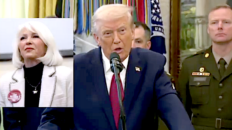This is Part 8 of a special 10-part documentary series released by NTD in July 2020, based on the book series of the same title, written by the editorial board of ‘Nine Commentaries of the Communist Party’, also published by the Epoch Media Group, which was founded in New York City by Chinese Falun Gong practitioners fleeing religious persecution by the CCP and its attendant “on-demand” forced organ harvesting.
***
OFFICIAL LINER NOTES
From the New Deal to Progressivism. On Thursday, October 24, 1929, the New York stock market crashed. The crisis spread from the financial sector to the entire economy, sparing none of the major developed nations of the West.
Unemployment spiked to over a quarter of the population, and the total number of unemployed exceeded 30 million. Apart from the Soviet Union, industrial production in major industrial countries dropped by an average of 27%.
In early 1933, within 100 days of Roosevelt’s inauguration, many bills were introduced around the theme of solving the crisis. The policies increased government intervention in the economy and passed major reforms: Congress enacted the Emergency Banking Act, Agricultural Adjustment Act, National Industrial Recovery Act, and Social Security Act.
Though Roosevelt’s New Deal was essentially ended by the outbreak of World War II, many of the institutions and organizations that emerged during the period have continued to shape American society to the present day.
Roosevelt issued more executive orders than the total number of such decrees hitherto issued by all presidents in the 20th century. Nevertheless, the American unemployment rate in the United States did not fall below double digits until after the war began. The New Deal’s real effect was to set the US government on a trajectory of high taxation, big government, and economic interventionism.
In his 2017 book, ‘The Big Lie: Exposing the Nazi Roots of the American Left’, conservative thinker Dinesh D’Souza argued that the National Recovery Act, which formed the centerpiece of Roosevelt’s New Deal, essentially meant the end of the US free market.
According to ‘FDR’s Folly’, a 2003 book by historian Jim Powell, the New Deal prolonged the Great Depression rather than ending it: the Social Security Act and labor laws encouraged further unemployment, while high taxes encumbered healthy business, and the like.
Economist and Nobel Prize Laureate Milton Friedman praised Powell’s work, saying: “As Powell demonstrates without a shadow of a doubt, the New Deal hampered recovery from the contraction, prolonged and added to unemployment, and set the stage for ever more intrusive and costly government.”





It is great to expose the dealings of Franklin Roosevelt and his New Deal program and what that encompassed, but don’t stop there. Roosevelt administration was the frightening beginning of Communism spreading through Europe and The United States, deliberately.
The United States, Britain and Canada saved Bolshevik/Occupied Communism Russia, by supplying them with 5,000 tanks, 7,000 fighter aircraft, 550 Royal air force pilots, 15 million pairs of Red Army boots and 6 million tons of food and other supplies all the while Roosevelt had food ration back at home. Bolshevik Russia was already losing to the Axis powers at the time of this salvation from the West.